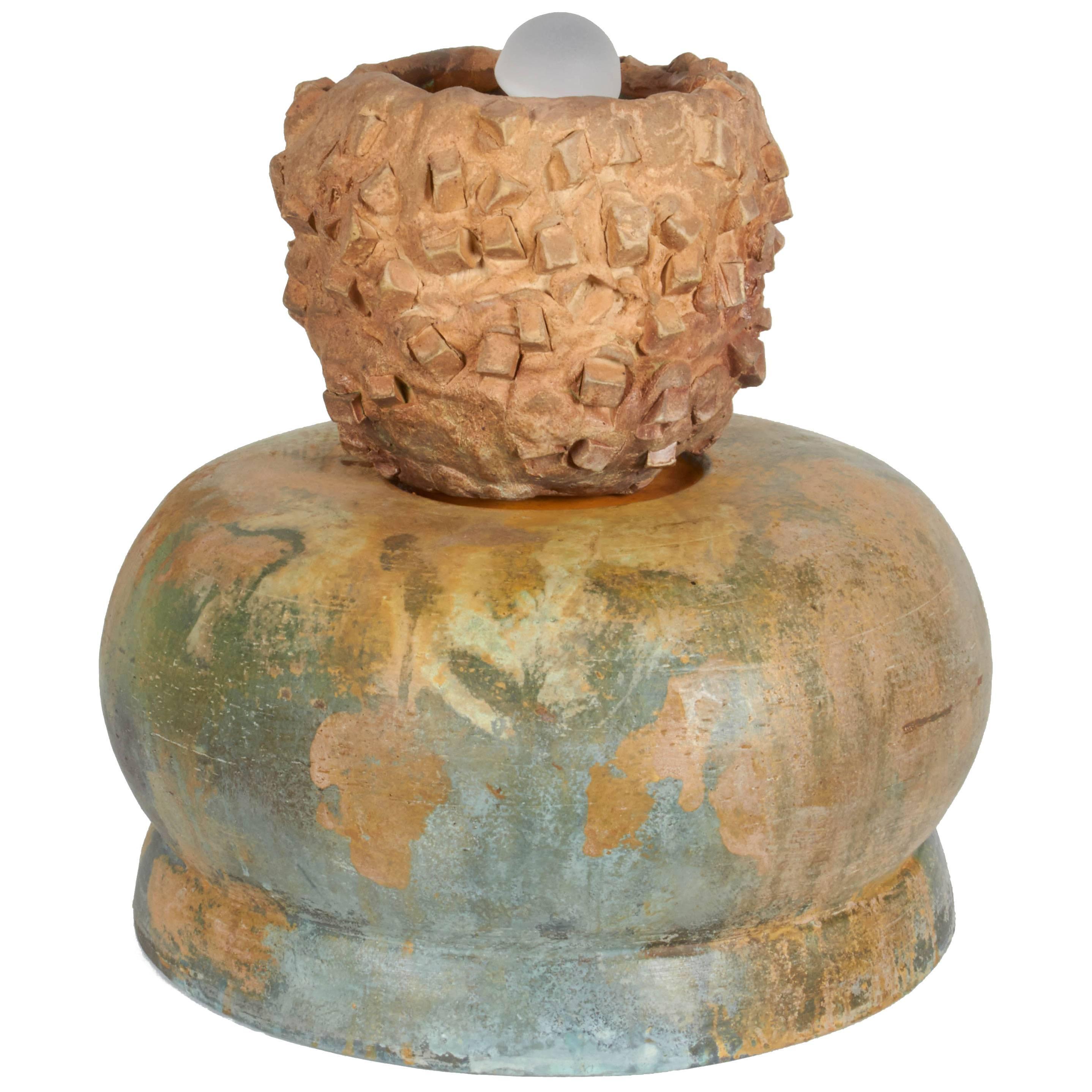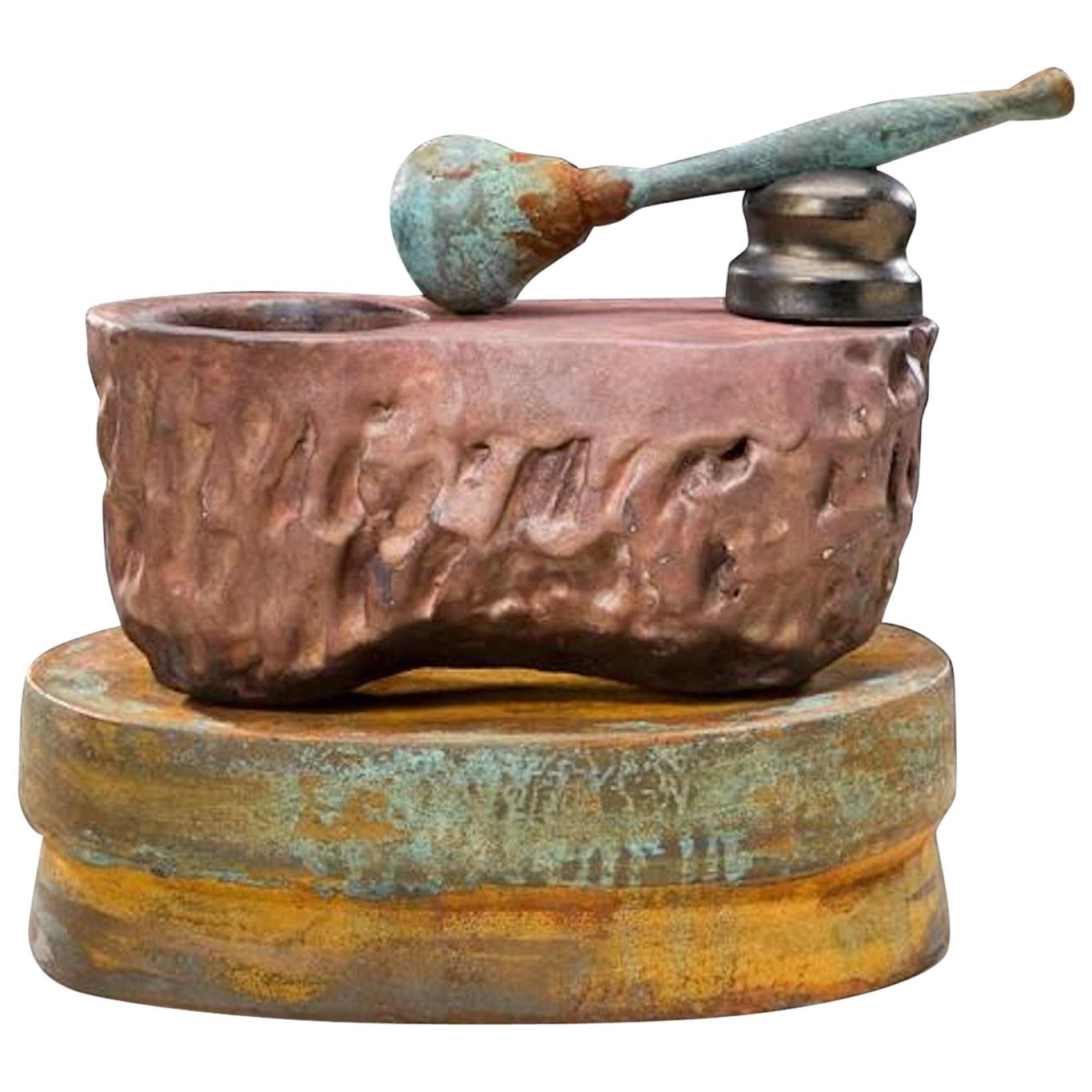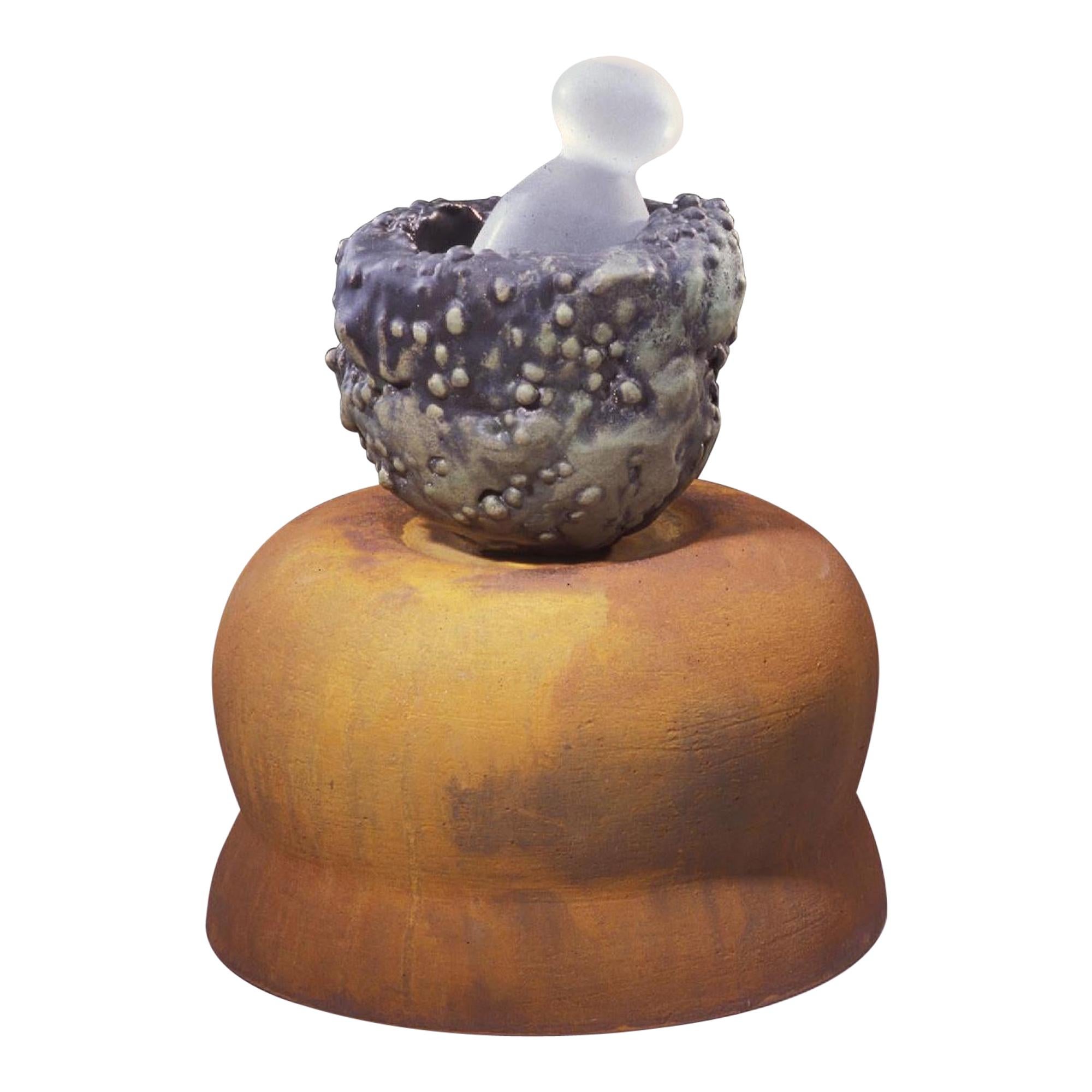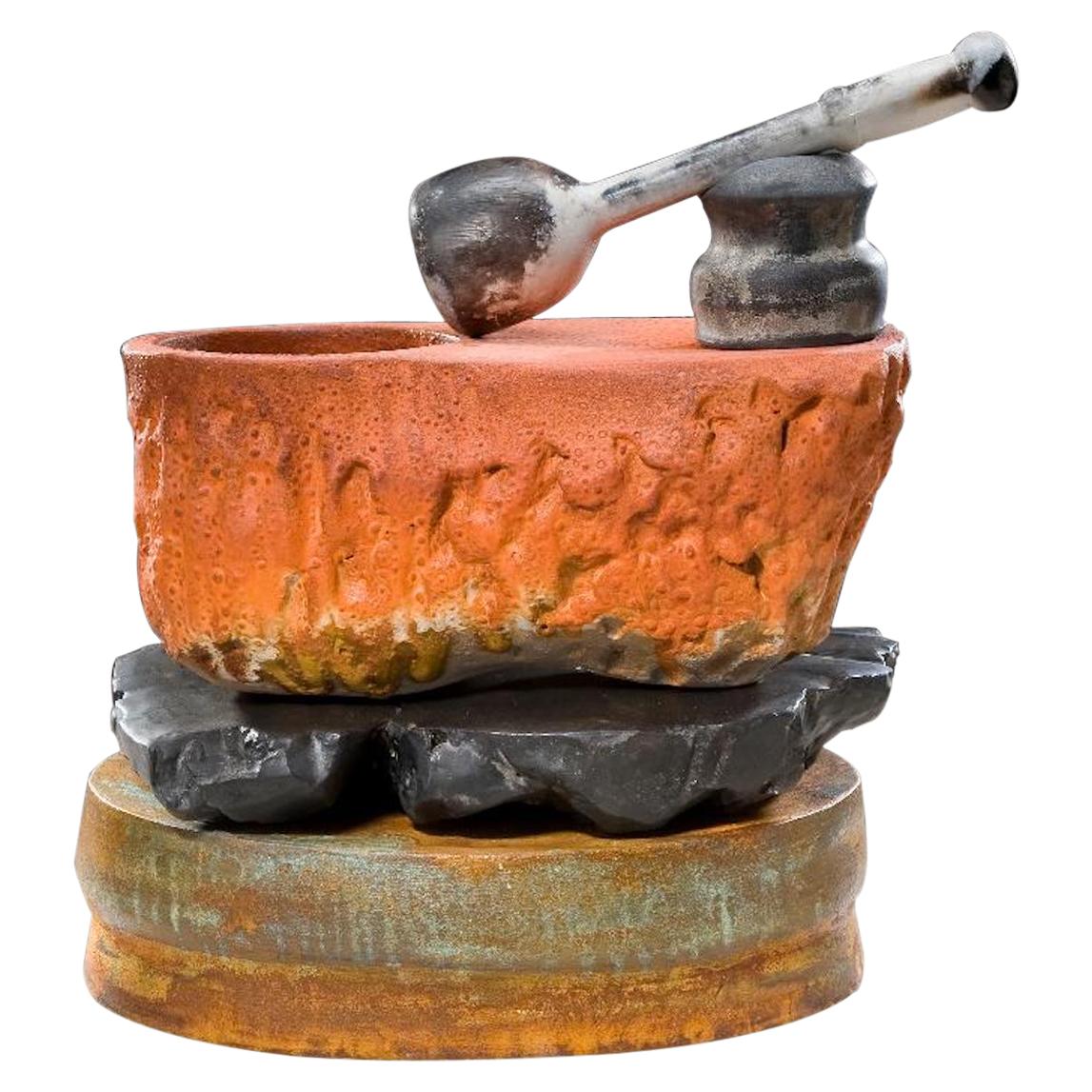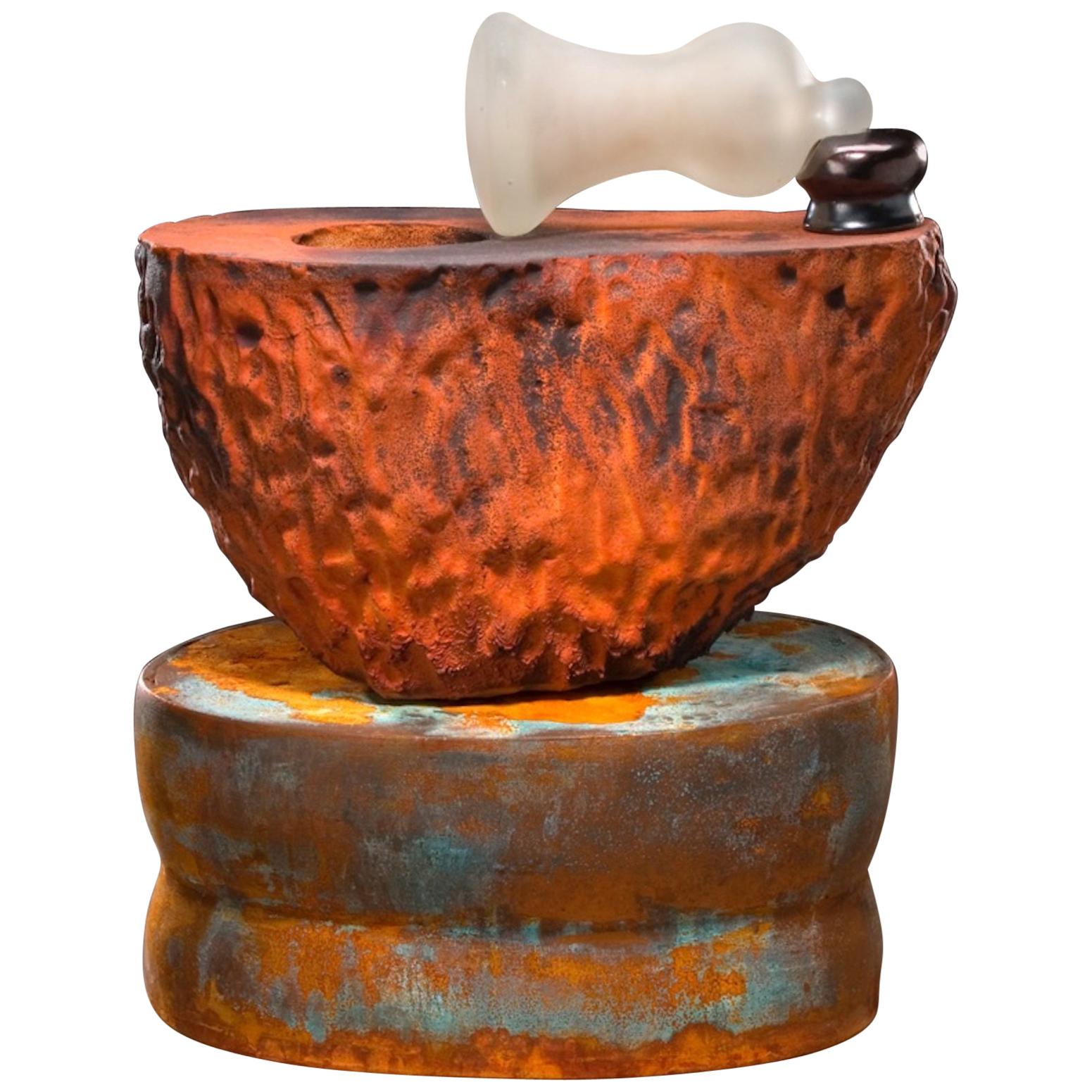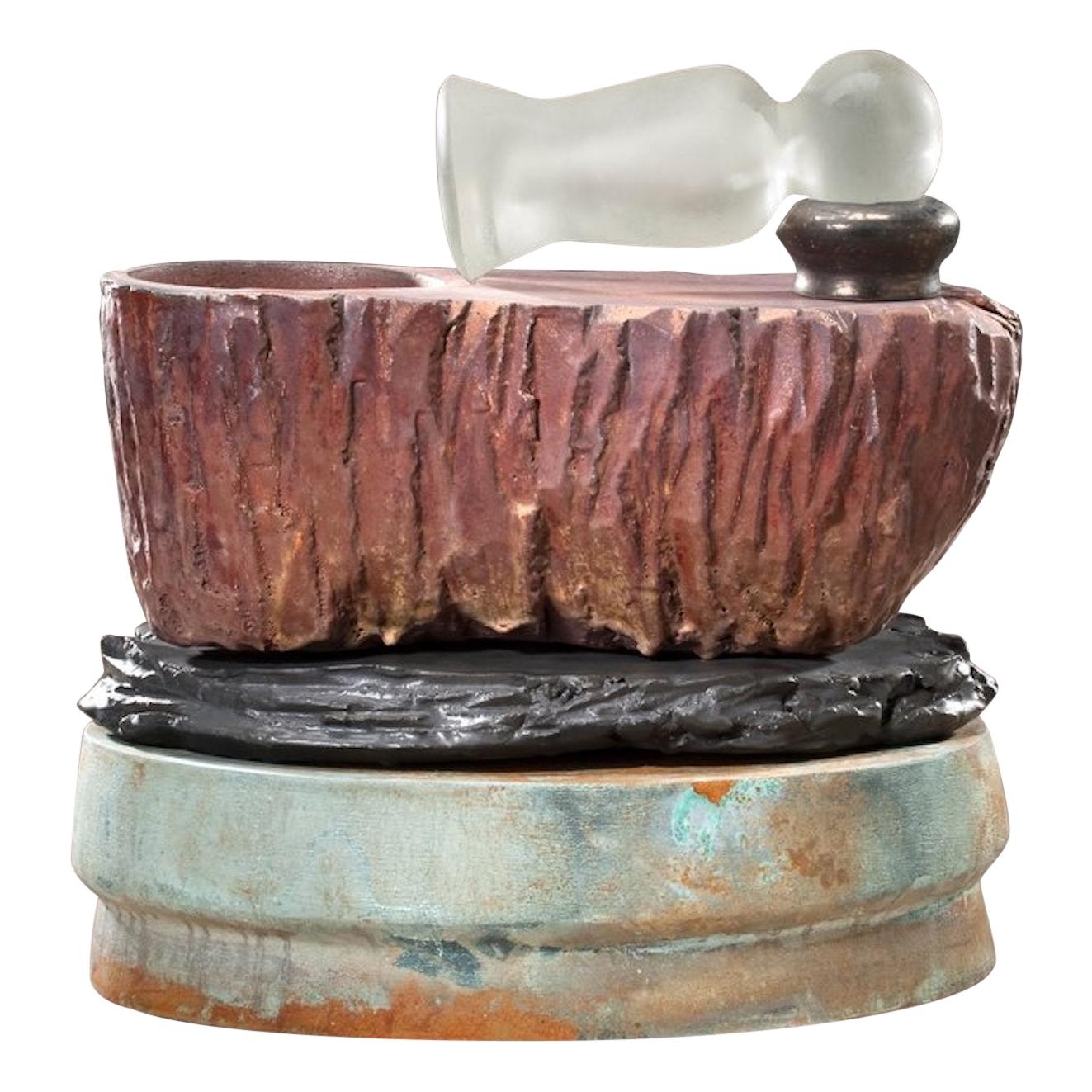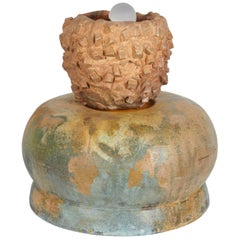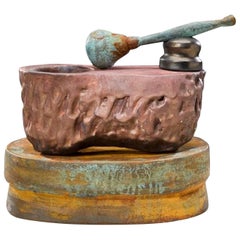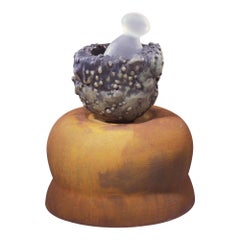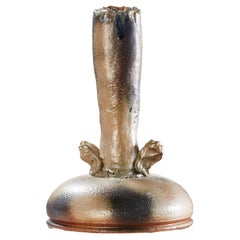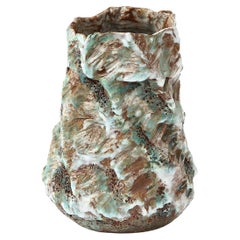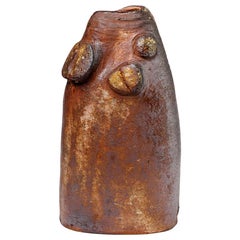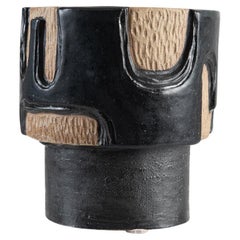Items Similar to Richard Hirsch Ceramic Mortar and Pestle, 2007
Want more images or videos?
Request additional images or videos from the seller
1 of 13
Richard Hirsch Ceramic Mortar and Pestle, 2007
$10,500per set
£7,929.18per set
€9,078.18per set
CA$14,828.74per set
A$16,189.44per set
CHF 8,487.46per set
MX$196,626.98per set
NOK 105,994.57per set
SEK 100,087.13per set
DKK� 67,758.96per set
About the Item
Contemporary American ceramic artist Richard Hirsch's Mortar and Glass Pestle #27 is raku-fired, hand built and hand sculptured. This piece is made of three separate pieces of green rust patinaed wood fired stoneware. "In his process, Hirsch is a reducer, endlessly honing and refining his forms to their simplest and most powerful presence. It is the same “less is more” aesthetic evidenced by the work of Noguchi, Brancusi, and Giacometti, artists he holds in greatest esteem. His content is principally the vocabulary of form, color, and surface, subtly referencing utility while defying overt narration and cultural specificity. A mortar and pestle like this one, for example, might be discernible in a piece, but presented with such economy that it becomes only important as a stand-in for larger issues; their anima/animus relationship or as a record of human use and wear over considerable time. For Hirsch, the particular only exists for the purpose of making the universal palpable. His is a point of view similar to the views of Joseph Campbell, whose eclectic study of human culture and spirituality yielded a sense of what is shared by all." Signed by the artist. This sculpture ships directly from the artist’s studio in Rochester, NY.
(Literature: "With Fire: Richard Hirsch, A Life Between Chance and Design", Scott Meyer (Author), RIT Cary Graphic Arts Press 2012 - "Mortars and Pestles" pgs. 57 - 60 and pictured on pg. 57 (Image: 7) / Exhibition catalog - "Recollections : Richard Hirsch, Michael Rogers" Richard Hirsch - artist, Michael Rogers - artist, Dr. Scott Meyer, Pittsburgh Glass Center - host institution (authors), Pittsburgh Glass Center 2008 - pictured on pg. 3)
Richard Hirsch Brief Bio:
In the field of contemporary ceramic, Rick Hirsch has earned an international reputation. He has achieved this recognition by engaging in numerous diversified professional activities. Through efforts in university teaching, exhibits, writing, lecturing and researching he has risen to worldwide prominence.
In 1975, Hirsch co-authored a book entitled Raku, published by Watson-Guptill. This was the first comprehensive text to address the new innovations developing in the west that were transforming traditional Japanese Raku. Also, in the same year, Hirsch became a founding faculty member of The Program in Artistry at Boston University. Currently, Hirsch is a Professor Emeritus at The School for American Crafts which is a part of Rochester Institute of Technology in Rochester, NY. His university teaching career now spans well over four decades.
Repeatedly, Hirsch has participated in several milestone exhibitions and publications. Significant shows include; The Evolution of American Art in Craft Media Since 1945; Echoes: Historical References in Contemporary Ceramics; American Ceramics Now; Raku: Origins, Impact and Contemporary Expression; and Convergences: The Presence of the Past in Contemporary American Ceramics.
Frequently his work appears in book and magazine publications, such as; Overseas Contemporary Ceramic Art Classics by Baiming, China; Raku Investigations into Fire by David Jones, England; The History of American Ceramics from 1607 to the Present by Elaine Levin, New York; World Contemporary Ceramics by Baiming, China; and Firing, Philosophies within Contemporary Ceramic Practice by David Jones, England.
Several museums have included his work for their permanent collections. These include; The Carnegie Museum of Art, Pittsburgh; The Renwick Gallery, Smithsonian Institute, Washington DC; The High Museum of Art, Atlanta; The Everson Museum of Art, Syracuse; The Nelson-Atkins Museum of Art, Kansas City, Missouri; The Taipei County Yinko Ceramics Museum, Taipei, Taiwan; and the George R. Gardiner Museum of Ceramic Art, Toronto, Canada.
In 1984, Hirsch was elected as a permanent member of The International Ceramics Academy, a worldwide organization headquartered in Geneva, Switzerland. A recipient of a William J. Fulbright Research Scholar Award in 2002, Hirsch has also received several Individual Artists Grants. Most recently he was honored by The Rochester Institute of Technology, with the Board of Trustees' Outstanding Scholarship Award. Recently Hirsch collaborated with Dr. Scott Meyer on his biography, the book is entitled With Fire: Richard Hirsch and is published by The Cary Graphic Arts Press at RIT, ISBN-13: 978-1-933360-97-3.
Amid the ever-shifting sands of change and new trends that is prevalent in contemporary ceramics, Richard Hirsch has maintained his steadfast personal aesthetic and continues to make a significant contribution to his field.
- Creator:Richard A. Hirsch (Artist)
- Dimensions:Height: 22 in (55.88 cm)Width: 12 in (30.48 cm)Depth: 12 in (30.48 cm)
- Sold As:Set of 3
- Style:Modern (In the Style Of)
- Materials and Techniques:
- Place of Origin:
- Period:
- Date of Manufacture:2007
- Production Type:New & Custom(One of a Kind)
- Estimated Production Time:Available Now
- Condition:
- Seller Location:New York, NY
- Reference Number:Seller: RH 0071stDibs: f86331507312800023fs
Variations/Additional sculptures and fine art in this collection are available, please contact the Seller for more information.
About the Seller
5.0
Vetted Professional Seller
Every seller passes strict standards for authenticity and reliability
Established in 2005
1stDibs seller since 2009
119 sales on 1stDibs
Typical response time: 1 hour
Associations
20th Century Specialists
- ShippingRetrieving quote...Shipping from: Churchville, NY
- Return Policy
Authenticity Guarantee
In the unlikely event there’s an issue with an item’s authenticity, contact us within 1 year for a full refund. DetailsMoney-Back Guarantee
If your item is not as described, is damaged in transit, or does not arrive, contact us within 7 days for a full refund. Details24-Hour Cancellation
You have a 24-hour grace period in which to reconsider your purchase, with no questions asked.Vetted Professional Sellers
Our world-class sellers must adhere to strict standards for service and quality, maintaining the integrity of our listings.Price-Match Guarantee
If you find that a seller listed the same item for a lower price elsewhere, we’ll match it.Trusted Global Delivery
Our best-in-class carrier network provides specialized shipping options worldwide, including custom delivery.More From This Seller
View AllRichard Hirsch Ceramic Mortar and Glass Pestle, 2004
By Richard A. Hirsch
Located in New York, NY
Contemporary American ceramic artist Richard Hirsch's Mortar and Glass Pestle #30 is raku-fired, hand built and hand sculptured. Two separate pieces of wood fired stoneware are assem...
Category
21st Century and Contemporary American Modern Abstract Sculptures
Materials
Ceramic, Glass
$10,500 / set
Richard Hirsch Ceramic Mortar and Pestle Sculpture #30, 2009
By Richard A. Hirsch
Located in New York, NY
Contemporary American ceramic artist Richard Hirsch's Mortar and Pestle Sculpture #30 was assembled in 2009. It's wheel thrown and hand built clay, slips and glazes with raku patinas. The following is an excerpt from the book "With Fire: Richard Hirsch, A Life Between Chance and Design" written by Scott Meyer; "The glass "masher" is lightly sand-blasted, suggesting opacity but yielding subtle light penetration, the perfect foil for Hirsch’s heavy clay concavities. Conceptually, Hirsch enjoys the compatibility of the two heat-driven materials, and the alchemical issues with shared chemistry seems right for themes involving vessels and raw geologic age." This four piece sculpture is signed and dated by the artist. It will ship directly from the artist’s studio in Rochester, NY.
(Literature: "With Fire: Richard Hirsch, A Life Between Chance and Design", Scott Meyer (Author), RIT Cary Graphic Arts Press 2012 - "Mortars and Pestles" pgs. 57 - 60. The Ceramic Mortar and Pestle...
Category
21st Century and Contemporary American Modern Abstract Sculptures
Materials
Ceramic
Richard Hirsch Ceramic Mortar and Glass Pestle Sculpture, 2007
By Richard A. Hirsch
Located in New York, NY
Contemporary American ceramic artist Richard Hirsch's Mortar and Glass Pestle Sculpture #1 was assembled in 2007. It's wheel thrown and hand built clay with green and black watermelon glaze, raku rust patina and hot blown glass. Two separate pieces of wood fired stoneware are assembled with a third piece -- a hot blown glass pestle. "The glass "masher" is lightly sand-blasted, suggesting opacity but yielding subtle light penetration, the perfect foil for Hirsch’s heavy clay concavities. Conceptually, Hirsch enjoys the compatibility of the two heat-driven materials, and the alchemical issues with shared chemistry seems right for themes involving vessels and raw geologic age." This three piece sculpture...
Category
21st Century and Contemporary American Modern Abstract Sculptures
Materials
Ceramic, Blown Glass
Richard Hirsch Ceramic Mortar and Pestle Sculpture, 2010
By Richard A. Hirsch
Located in New York, NY
Contemporary American ceramic artist Richard Hirsch's Mortar and Pestle Sculpture was assembled in 2010. It's wheel thrown and hand built clay, lowfired slips, black glaze, raku pati...
Category
21st Century and Contemporary American Modern Abstract Sculptures
Materials
Ceramic
Richard Hirsch Ceramic Mortar and Blown Glass Pestle Sculpture #23, 2006
By Richard A. Hirsch
Located in New York, NY
Contemporary American ceramic artist Richard Hirsch's Mortar and Glass Pestle Sculpture #23 was assembled in 2006. It's wheel thrown and hand built clay with low fire slips and glazes, raku patinas and hot blown glass. The following is an excerpt from the book "With Fire: Richard Hirsch, A Life Between Chance and Design" written by Scott Meyer...
Category
21st Century and Contemporary American Modern Abstract Sculptures
Materials
Blown Glass, Ceramic
Richard Hirsch Ceramic Mortar and Hot Blown Glass Pestle Sculpture, 2009
By Richard A. Hirsch
Located in New York, NY
Contemporary American ceramic artist Richard Hirsch's Mortar and Glass Pestle Sculpture was assembled in 2009. It's wheel thrown and hand built clay with red and black glazes, raku patinas and a hot blown glass pestle. The following is an excerpt from the book "With Fire: Richard Hirsch, A Life Between Chance and Design" written by Scott Meyer...
Category
21st Century and Contemporary American Modern Abstract Sculptures
Materials
Blown Glass, Ceramic
You May Also Like
Pottery Vessel or Sculpture by noted American Potter Don Reitz
By Don Reitz
Located in Greensboro, NC
Large impressive pottery sculpture, vessel form, by Don Reitz (1929-2014)
Via 1stdibs:
Don Reitz
AMERICAN, 1929-2014
Donald Lester Reitz was an American ceramic artist, recogn...
Category
Mid-20th Century American Mid-Century Modern Abstract Sculptures
Materials
Pottery
$2,276 Sale Price
20% Off
X-Large Sculptural Vase #4 by Dena Zemsky
By Dena Zemsky
Located in New York, NY
Glazed ceramic. Hand built, large-scale vase. Light blue glazed interior and textured exterior. Artist-signed on underside.
Category
21st Century and Contemporary American Modern Vases
Materials
Ceramic
Ceramic Sculptural Vase to La Borne, Signed at the Base, circa 1970
By Martin Hammond
Located in Saint-Ouen, FR
A big ceramic vase to La Borne.
Perfect original conditions.
circa 1970.
Signed at the base.
Category
20th Century French Beaux Arts Vases
Materials
Ceramic
Moderno Pedestal Vessel in Glazed Stoneware by Trish DeMasi
By Trish DeMasi
Located in Philadelphia, PA
Trish DeMasi
Moderno pedestal vessel, 2021
Glazed and raw speckled stoneware
Measures: 7 x 7 x 8 in.
Category
21st Century and Contemporary American Ceramics
Materials
Ceramic
EXPERIMENTAL MODERNIST CERAMIC 3 piece sculpture, 1970S
Located in AMSTERDAM, NL
Experimental 3 piece ceramic sculpture by a Dutch ceramists.
This stunning piece combines an experimental shape and glazing, with a intruding concept in function: together the 3 piec...
Category
20th Century Planters, Cachepots and Jardinières
Materials
Clay
$317 Sale Price
64% Off
Large Studio Pottery sculpture Vase by Ronald Ehrlich.
Located in Philadelphia, PA
Beautiful tall sculpture by Rhode Island ceramasist and painter Ronald S. Elhrich. Can be a stand alone sculpture or a vase for tall dry flowers. has a beautiful scraffitto and gla...
Category
1990s American Mid-Century Modern Vases
Materials
Ceramic
More Ways To Browse
American Ceramic Artists
Stacked Objects Sculpture
American Limoges
Modernist Wood Carved Sculpture
Brushed Aluminum Sculpture
Craft Sculpture Studio Wood
Moon Sculpture Bronze
Bonsai Tree Sculpture
Ladder Sculpture
Metal Cube Sculpture
Tall Black Modern Sculpture
Brancusi Style
Bronze Sculpture Brazil
Japan Cast Iron Mid Century Modern
Polished Chrome Sculpture
Acrylic Sculpture 1970s
Constructivist Wood Sculpture
Glass Mannequin Head
